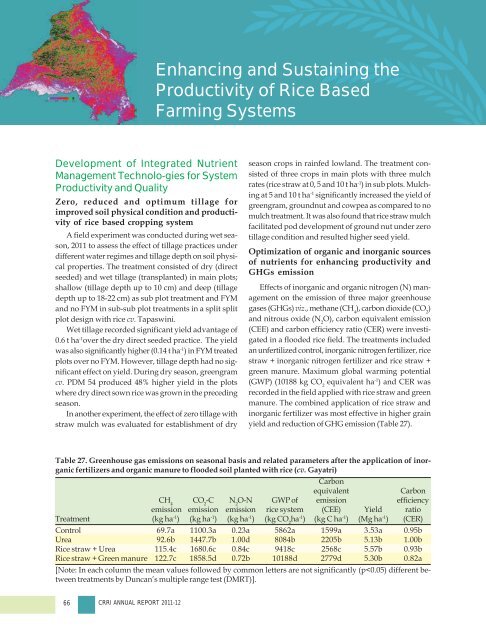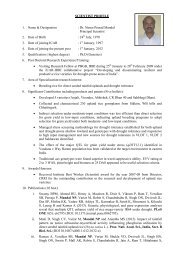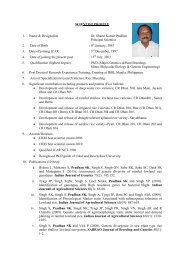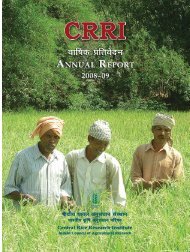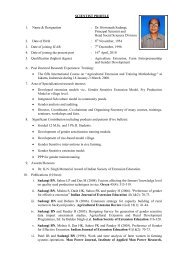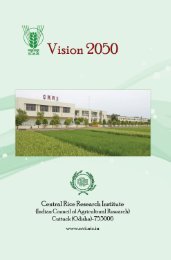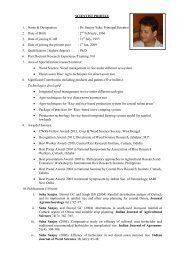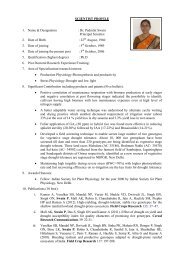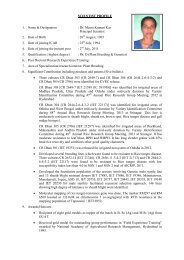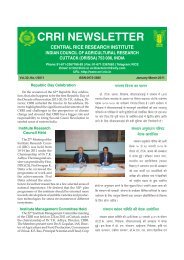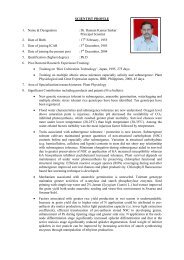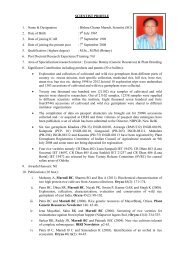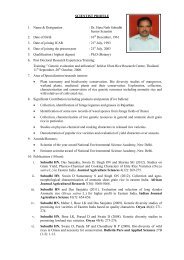Central Rice Research Institute Annual report...2011-12
Central Rice Research Institute Annual report...2011-12
Central Rice Research Institute Annual report...2011-12
Create successful ePaper yourself
Turn your PDF publications into a flip-book with our unique Google optimized e-Paper software.
Enhancing and Sustaining the<br />
Productivity of <strong>Rice</strong> Based<br />
Farming Systems<br />
Development of Integrated Nutrient<br />
Management Technolo-gies for System<br />
Productivity and Quality<br />
Zero, reduced and optimum tillage for<br />
improved soil physical condition and productivity<br />
of rice based cropping system<br />
A field experiment was conducted during wet season,<br />
2011 to assess the effect of tillage practices under<br />
different water regimes and tillage depth on soil physical<br />
properties. The treatment consisted of dry (direct<br />
seeded) and wet tillage (transplanted) in main plots;<br />
shallow (tillage depth up to 10 cm) and deep (tillage<br />
depth up to 18-22 cm) as sub plot treatment and FYM<br />
and no FYM in sub-sub plot treatments in a split split<br />
plot design with rice cv. Tapaswini.<br />
Wet tillage recorded significant yield advantage of<br />
0.6 t ha -1 over the dry direct seeded practice. The yield<br />
was also significantly higher (0.14 t ha -1 ) in FYM treated<br />
plots over no FYM. However, tillage depth had no significant<br />
effect on yield. During dry season, greengram<br />
cv. PDM 54 produced 48% higher yield in the plots<br />
where dry direct sown rice was grown in the preceding<br />
season.<br />
In another experiment, the effect of zero tillage with<br />
straw mulch was evaluated for establishment of dry<br />
season crops in rainfed lowland. The treatment consisted<br />
of three crops in main plots with three mulch<br />
rates (rice straw at 0, 5 and 10 t ha -1 ) in sub plots. Mulching<br />
at 5 and 10 t ha -1 significantly increased the yield of<br />
greengram, groundnut and cowpea as compared to no<br />
mulch treatment. It was also found that rice straw mulch<br />
facilitated pod development of ground nut under zero<br />
tillage condition and resulted higher seed yield.<br />
Optimization of organic and inorganic sources<br />
of nutrients for enhancing productivity and<br />
GHGs emission<br />
Effects of inorganic and organic nitrogen (N) management<br />
on the emission of three major greenhouse<br />
gases (GHGs) viz., methane (CH 4<br />
), carbon dioxide (CO 2<br />
)<br />
and nitrous oxide (N 2<br />
O), carbon equivalent emission<br />
(CEE) and carbon efficiency ratio (CER) were investigated<br />
in a flooded rice field. The treatments included<br />
an unfertilized control, inorganic nitrogen fertilizer, rice<br />
straw + inorganic nitrogen fertilizer and rice straw +<br />
green manure. Maximum global warming potential<br />
(GWP) (10188 kg CO 2<br />
equivalent ha -1 ) and CER was<br />
recorded in the field applied with rice straw and green<br />
manure. The combined application of rice straw and<br />
inorganic fertilizer was most effective in higher grain<br />
yield and reduction of GHG emission (Table 27).<br />
Table 27. Greenhouse gas emissions on seasonal basis and related parameters after the application of inorganic<br />
fertilizers and organic manure to flooded soil planted with rice (cv. Gayatri)<br />
Carbon<br />
equivalent<br />
Carbon<br />
CH 4<br />
CO 2<br />
-C N 2<br />
O-N GWP of emission efficiency<br />
emission emission emission rice system (CEE) Yield ratio<br />
Treatment (kg ha -1 ) (kg ha -1 ) (kg ha -1 ) (kg CO 2<br />
ha -1 ) (kg C ha -1 ) (Mg ha -1 ) (CER)<br />
Control 69.7a 1100.3a 0.23a 5862a 1599a 3.53a 0.95b<br />
Urea 92.6b 1447.7b 1.00d 8084b 2205b 5.13b 1.00b<br />
<strong>Rice</strong> straw + Urea 115.4c 1680.6c 0.84c 9418c 2568c 5.57b 0.93b<br />
<strong>Rice</strong> straw + Green manure <strong>12</strong>2.7c 1858.5d 0.72b 10188d 2779d 5.30b 0.82a<br />
[Note: In each column the mean values followed by common letters are not significantly (p


